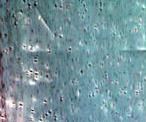Stop Those Gels!
Gels are an unsightly but common problem in single-screw extrusion.
Gels are an unsightly but common problem in single-screw extrusion. They can be large or small, hollow or solid, clear or discolored. They appear in sudden “showers,” discrete stripes, or randomly dispersed. By identifying the specific type of gel and circumstances of its appearance, you stand a much better chance of tracking down and fixing the cause—whether it stems from problems in raw material, processing, or equipment.
Know your gel types
Platelets, fisheyes, or disc-shaped gels are round and thickest at the center. Cut them open, and you won’t find any discoloration. These types of gels come from two sources: crosslinking and unmelts. Both crosslinked and unmelted gels can get through screen packs and disrupt polymer flow farther downstream.
Crosslinked gels are formed by overheating the resin. They melt at a higher temperature than the surrounding resin. Crosslinked gels can come from raw-material contamination or use of too much reclaim. Unmelted gels have the same melting point as the surrounding resin, but remained colder than the average melt temperature. Causes include heating too quickly in the feed zone, melting too slowly in the transition zone, insufficient mixing, and excessive heat loss in the adapters or die. The preferred solution is to increase mixing time (recirculation flow in the metering section of the screw) by adding screens to raise backpressure.
Another strategy for eliminating unmelts is to use what is commonly referred to as a “humped” temperature profile. First, lower the feed-zone temperature, which will result in more intensive friction in the transition zone. Screw motor amperage will usually increase. Average melt temperature may increase noticeably, so watch out for crosslinked, discolored, or burnt gels if friction is too severe. You may also have to lower the last barrel zone to cool the melt.
Pinpoint gels, referred to as “applesauce,” look like dust particles entrapped in resin. Causes include material contamination or too much reclaim. Another possible cause is incomplete melting. The preferred remedy is to heat the material more quickly by increasing frictional shear. A second option is to increase heating time by reducing screw speed, but this also reduces output.
Other possible culprits are insufficient backpressure or contamination from a dirty screw. If you need to raise backpressure, the preferred solution is to add more screens and increase screw speed. Expect the melt temperature to rise somewhat.
Hollow gels, referred to as “lensing,” occur when vapor is trapped in the melt and carried forward to the die. Causes include wet resin or gases produced as the resin heats up. Pellets can get wet from condensation when resin is sucked from a cold silo into the hopper during winter. A solution is to allow resin to warm up inside the factory before using it. For hygroscopic materials like nylon and PET, make sure the resin is properly dried.
Other causes are insufficient heating in the feed section or turning the screw too fast. Air is normally forced backwards into the feed throat as the solid granules are compressed prior to melting. If only the surface of the granules melts before the pellets are compressed, air can get trapped.
The solution is raising the temperature in the first and second extruder zones so that the granules soften, compress, and squeeze the air out before melting begins. Another solution is to reduce your screw speed, but this also reduces output. Other causes to look for are insufficient drying or funnel flow inside the drying hopper—when material at the center flows quickly while material near the wall stagnates.
Gels can also appear as arrowheads, chevrons, and V or J shapes. Causes again include resin contamination or use of too much reclaim. If pro cessing conditions are at fault, the problem is likely to be too low a temperature of the melt or die or too little backpressure, all of which result in insufficient mixing. The preferred solutions are increasing frictional shear by lowering extruder feed and transition zone temperatures. Raising adapter and die temperatures may solve the problem if heat is being lost too rapidly after the extruder.
Discolored gels are caused by overheating or burning. Material causes include contamination, too much reclaim, or insufficient antioxidant. Faulty processing conditions to look for are excessive frictional shear inside the extruder, too hot a die, or too much recirculation flow in the metering section.
Possible equipment problems are a clogged screen pack or dirty screw or die. Or, you could be using the wrong screw and/or barrel, a screw that’s too short, adapters and flow channels that are too wide, inappropriate die design, or incorrect heater or thermocouple locations. One solution is to maintain sufficient shear to wipe the metal surfaces constantly, since most polymer degradation occurs when polymer contacts metal for too long.
It’s also possible that you are overheating the resin locally in certain parts of the extruder screw. Variable-depth melt thermocouples in the adapter can often detect this problem even when barrel temperature controllers do not detect overheating.
Patterns of occurrence
If gels are randomly dispersed, they usually come from the raw material or the extruder. Raw-material problems that produce gels include contamination, too much recycled or reclaimed material, and insufficient antioxidant. Always check for contamination first because it’s easy to detect and simple to fix. If gels form in lanes in the machine direction, alternating with lanes free of gels, the problem is usually downstream from the extruder in the die or die block.
When large quantities of gels repeatedly appear and disappear, the phenomenon is called gel showers. They may be caused by improper processing conditions and are common when materials with very different melting rates are blended together. Pigment masterbatches, for example, are designed to melt quickly to maximize mixing time in the extruder. But if the feed zone is too hot, pigment granules melt too quickly and become encrusted on the screw. Encrusted granules then break off occasionally, resulting in a sudden cascade of gels the same color as the pigment masterbatch. They aren’t burnt gels, just heavily pigmented unmelts. Extruder motor amps will rise because the sudden increase in pigment concentration adds more friction to the transition zone. The preferred solution is to lower the temperature slightly in both the feed and transition zones to delay melting of the masterbatch.
Related Content
How to Estimate and Control Head Pressure
You rightfully worry about melt temperature, but don’t overlook head pressure, because the two are closely linked and will influence line performance.
Read MoreWhy Compression Ratio is Important
Compression ratios have been pretty much standardized over the years, based on what has typically worked before. But there are quite a few variables that must be considered in order to get the optimum performance from your screw.
Read MoreUnderstanding the ‘Science’ of Color
And as with all sciences, there are fundamentals that must be considered to do color right. Here’s a helpful start.
Read MoreSpecialty Purging Compounds Optimize Color and Material Changeovers
Selecting of the correct purging compound can speed up material and color changeover time and reduce scrap. You’ll even save on material.
Read MoreRead Next
How Polymer Melts in Single-Screw Extruders
Understanding how polymer melts in a single-screw extruder could help you optimize your screw design to eliminate defect-causing solid polymer fragments.
Read MorePeople 4.0 – How to Get Buy-In from Your Staff for Industry 4.0 Systems
Implementing a production monitoring system as the foundation of a ‘smart factory’ is about integrating people with new technology as much as it is about integrating machines and computers. Here are tips from a company that has gone through the process.
Read MoreLead the Conversation, Change the Conversation
Coverage of single-use plastics can be both misleading and demoralizing. Here are 10 tips for changing the perception of the plastics industry at your company and in your community.
Read More




















.png;maxWidth=300;quality=90)











